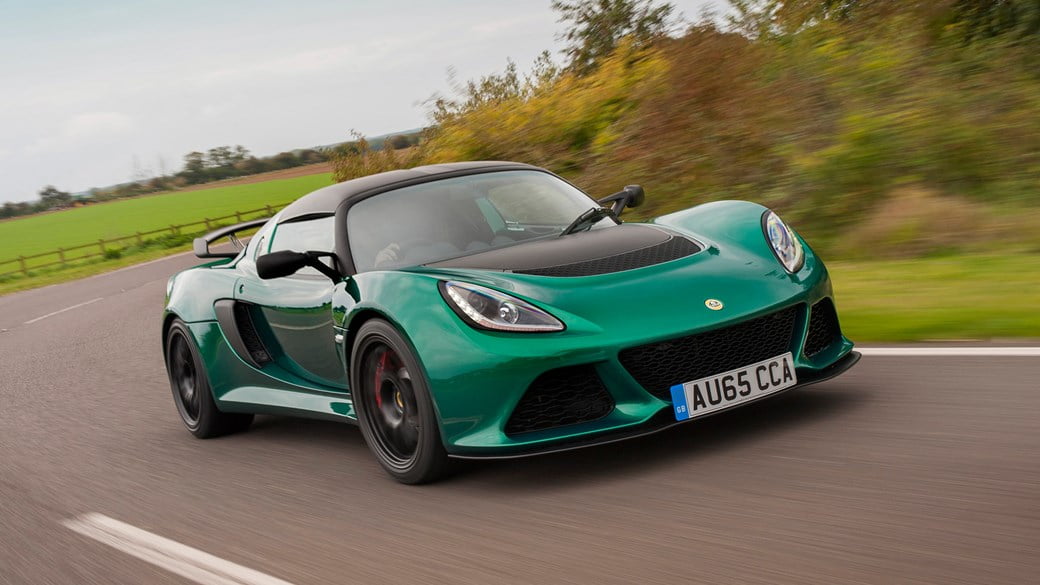
If the Lotus Exige Sport 350 looks familiar, that’s because it builds on the Exige S, which debuted in 2012. Hence both cars are based around the Elise’s extruded aluminium tub, but with a new rear subframe and bodywork to house the Toyota-sourced 3.5-litre supercharged V6.
But there are some big changes too. Lotus has been through the Exige S, stripping weight wherever possible, tweaking the chassis and generally fettling the entire package. The resulting 350 Sport weighs 51kg less than the Exige S at 1125kg, and laps the Hethel test track in 1min 29.8sec – 2.5 seconds faster than before. Crucially, that lap time was recorded on Pirelli P-Zero Corsa tyres, where the S lapped on more hardcore optional Trofeos, which are no longer road legal. The price rises from £54,500 for the Exige S to £55,900 for the Sport 350.
Where’s that 51kg weight saving come from?
Everywhere. Last summer, Lotus stripped an Exige S, and got engineers, assembly-line staff and suppliers to suggest how they could make the car lighter. You’ll probably spot the new louvred engine cover, which shaves 3kg; a new engine subframe saves 3kg; a new battery and mounting bracket 3.5kg; lighter body panels 12kg. The 350 Sport was also homologated without its air-con system, a 7.5kg saving that you’ll probably want to add back in
Lotus boss Jean-Marc Gales is at pains to mention that many modifications not only saved weight, but often also saved money (we all want Lotus to be profitable, right?) and increased quality. He points to the modifications to the heater pipe system, for instance, which cut 3kg and improved heating performance, and cites the Evora handbrake that he says not only looks ‘more premium’, but also saves 26g; and careful removal of sound deadening in certain areas has saved 2.7kg without, it’s claimed, adversely affecting the already-pretty-loud cabin.
There are also lightweight options, including ten-spoke forged alloy wheels, two-piece brakes with aluminium bells and four-piston brakes. Our test car has both options.
The result is a car that’s 5kg lighter than the V6 Cup, the even more hardcore version of the Exige S that was so loud inside you had to shout to converse and then still struggled to be heard.
How much more power has it got?
None. The Sport 350 gets 345bhp and 295lb ft, the same as the Exige S. Now, clearly, Lotus has added 50bhp extra to the Evora – same engine – mainly by adding an intercooler and making calibration changes, but Gales says the power-to-weight maths didn’t stack up in the same way for the Exige, which did have enough space to house the intercooler if required. It’s significantly lighter than the Evora, so the 40kg extra weight of the intercooler and piping – and for the LSD to handle the power, in the case of the Evora – wasn’t deemed worth it, nor the extra power necessary.
Instead, the extra speed has come from weight removal and a revised chassis, including front camber that’s doubled from 0.40deg to 0.80deg, front toe from 0.06deg to 0.12deg, and rear camber from -1.9deg to -2.1deg, the maximum possible. The front wheels remain 17 inches in diameter, the rears 18s, and the tyres are still 205/45 R17 and 265/35 R18 Pirelli P-Zero Corsas, but the rears are stretched over 10J rims that are half-an-inch wider.
The springs and dampers remains the same, but because they’re springing and damping a lighter car, they’re effectively stiffer.
Anything to report inside?
The big news is the exposed manual gearshift. It looks like a cyborg limb, saves weight, and, says Lotus, increases shift precision. It’s far prettier than the auto gearbox, with its budget PRND panel between the front seats, and (much nicer) aluminium shift paddles fixed to the small-diameter rim.
The optional carpeting also runs up the sills, for a more cohesive look, and you get Tartan seats, which reference the 1976 Lotus Esprit S1. Not my kind of thing, but you can always choose alcantara or leather.
How does it drive?
You notice the unassisted steering first – it’s heavy at car-park speeds and at 90-degree junctions, but mostly it’s a delight, jiggling in your hands and conveying so much surface detail that it can at first seem like overload now we’ve all acclimatised to electrically assisted systems. It’s quick and precise too, jinking the Exige’s nose into corners with a complete absence of slop or body roll. The Exige doesn’t lock onto cambers – in fact it flows down a bumpy road very well – but I’m pretty sure the geometry changes have altered the steering’s character, as you’d expect. To me, it now feels a little stickier, and keener to stay pointed in the direction you turned in; I like the steering a lot, but I suspect the S was sweeter still.
You couldn’t call the suspension supple in the way you can aMcLaren 650S, and certainly the Evora 400 is more pillowy, but the 350 Sport does marry exceptional body control with a certain absorbency, so you can hammer across a B-road knowing you’ll never be bounced off line, or tugged around at the mercy of the camber whenever you brake. Precise, connected and adequately comfortable, the chassis tuning works for me.
Is it quick?
Oh lordy yes. 345bhp is pretty middling these days, but that 1125kg kerbweight and a big fat wodge of torque ensure you’re fired up the road in double-quick time. The engine is tractable from basically idle speed, and picks up so eagerly that you’re unaware of waiting for any kind of kick. Third gear is all you’ll need to overtake dawdling traffic, even with limited straights.
Throttle response is keen, and seems both more positive – perhaps because there’s no intercooler pipework for the air to force its way through – and more successfully mapped than the Evora 400.
It’s not a particularly nice sound, but there is drama to the V6’s rumbles and grumbles, it gets louder in Sport and Race modes, and it revs impressively to just beyond 7000rpm without feeling like you’re mercilessly thrapping it.
And, then, if you’ve ticked the correct box – as 85% of Brits will – you’ll select the next gear manually. The pedals are of course still dramatically offset owing to the huge chassis sills – you notice even more in the left-hand-drive cars for some reason – but the gear change mechanism feels noticeably tighter than before, the final clunk of engagement seeming much more positive. On the road, the revised gear change helps to make this a more satisfying car to drive than the already excellent S, but it’s quite a narrow gate, and on track I fluffed down-changes into second.
You could get the auto, but I wouldn’t. The travel of the fixed gear shift paddles is so leisurely that I’m not sure you move the manual gear lever any further. And the shifts themselves still seem to move between fuzzy and a little abrupt.
On track, I’d sooner have a race-car-style sequential manual gearbox from the likes of Sadev than either the manual or the auto.
Track? What’s it like on track?
It’s brilliant. The last time I drove the Exige S, it was on a perfectly dry day, the car fitted with the now-banned – and very sticky – Trofeo tyres, so it’s difficult to compare the handling balance, and say if there’s less understeer, which was one of the aims. Certainly in the damp you have to be patient to get the front end keyed in, but it’d be optimistic to expect anything else from any car. And the window between slipping into a little understeer, then backing off and straightening your line with a helping of oversteer is tight enough to really keep you on your toes. But, again, the track was damp, the conditions pretty tricky, and overall the Exige feels well balanced, keen to change direction, and telegraphs its limits very clearly.
Lotus Dynamic Performance Management – trick stability control –works brilliantly, subtly stepping in to temper your exuberance without becoming heavy-handed; I suspect a lot of people might never notice it at all, and only Ferrari has anything close.
Similarly, the four-piston brakes offer mighty stopping power, and only seem to trigger ABS when the situation is completely beyond hope, and even then you still feel like you can modulate the pedal.
Verdict
The Exige 350 Sport is not the perfect sports car, but this is a niche that Lotus can own far more convincingly than it can with the Evora. Far rawer than a 911 GT3, similar money to aCayman GTS, yet almost as thrilling and far more practical than a Caterham, the Exige Sport 350 is the Lotus we’d buy. Make ours a manual with alcantara.
[“source-carmagazine”]





